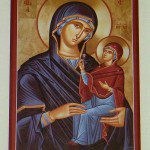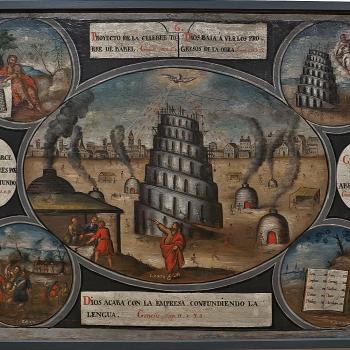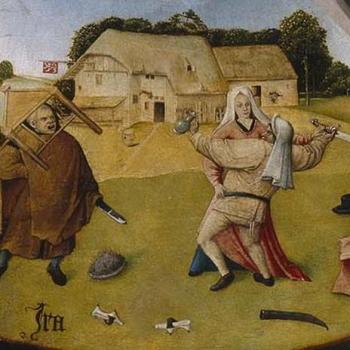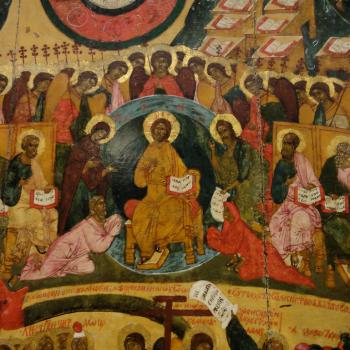“Beware of practicing your piety before men in order to be seen by them; for then you will have no reward from your Father who is in heaven” (Matt. 6:1 RSV). It is so easy for us to feign holiness, to give ourselves over to the expectations of others, if all we seek is their praise. We can shape our words and actions for popular acclaim, and if we do it well enough, we will attain the kind of reputation which we seek. But, Jesus warned us, that is all we will get. “Thus, when you give alms, sound no trumpet before you, as the hypocrites do in the synagogues and in the streets, that they may be praised by men. Truly, I say to you, they have received their reward” (Matt. 6:2 RSV). Since our goal would not be true holiness, but only its imitation, only its illusion to fool others, no interior transformation is attained by such activity. We might fool others by pleasing them, doing and saying what they want to hear (and in the process make much of ourselves in the world), but it is all for show, and deep inside, it will all ring hollow.
Thus, when we act out of a desire to please the world, to please others and their expectations for us, there is no fear of God, no true love inside which fears betraying God’s love. When we truly love God, it is in and with love that true fear of God is found, the fear a lover has when around their beloved, the love which seeks to please their beloved while concerned that they do no not do so. This kind of fear develops out of faith and so produces true fidelity because such faith knows that God is love and knows the terrible pain and sorrow we have already inflicted upon God due to our previous betrayal of his love. We have pierced him to the core of his being, through his great and sacred heart of love, crucifying him by our sins. “But God shows his love for us in that while we were yet sinners Christ died for us” (Rom. 5:8 RSV). God, who is love, reconciled himself to us by his beautiful act of love. He willingly took all that we could throw at him in and through our hate, which is the product of our sin. Though we killed Jesus, the God-man, through our acts of sin, our unlove, love proved stronger than hate, and the power of our sin ended in his death.[1] Love outlasted hate, and so Jesus, the God-man, the one who comes to us in the form of love to show the power of love, showed us true love is stronger than hate as he rose again in triumph.
When we have seen the beauty of true love, we find our hearts affected by its greatness; its glory turns our hearts away from ourselves and back to him as we seek him out on the path of love. This is the foundation of true holiness. This is what true fear of God entails, and why, as St. Isaac the Syrian explained, it is able to truly transform us inside out:
The beginning of virtue is the fear of God [which] is said [to be] the offspring of faith. Indeed it is sown in the heart when a man allows his mind to contain its roving impulses from the distractions of the world within the inner illuminations which arise from reflection on the order of things to come. In laying the foundation of virtue, the first of its peculiar elements is when we withdraw ourselves in flight from things toward the luminous word of the straight and holy paths, that word which was called an enlightener by the Psalmist inspired by the Holy Spirit.[2]
![St Mary of Egypt by Anonymous (Icons of Saints at the Orthodox Christian Page.) [Public domain], via Wikimedia Commons](https://wp-media.patheos.com/blogs/sites/637/2016/03/Mary_of_Egypt-254x300.gif)
St. Mary of Egypt had started out far from God. As a young woman of twelve, she had left her home and family and moved to Alexandria so that she could live the life she wanted to have, a libertine life of sexual freedom. While she lived a life similar to a prostitute, instead of charging men for sex, she gave herself over to her lust and gave her body to anyone who desired it, not asking for any payment. She wanted sex, and found it was its own reward, showing the way sin, once it infects us, quickly transforms us to being its slave. To survive between her sexual escapades, she would be found begging on the street, or making some minor crafts to sell.[4] In the end, about seventeen years after she went to live her life on her own, she joined in with a group of pilgrims who made a journey to Jerusalem to celebrate the feast of the Holy Cross. While on the way there she continued with her sexual escapades with any of the pilgrims who would lie down with her, but once she got to Jerusalem, her whole life would change. She found herself outside of church, with an icon of the Theotokos over the door, mysteriously unable to enter. Her life, as it were, came before her, and she saw how her sins had barred her from true happiness with God, and then and there, praying to Mary the Mother of God, said she would reform her life and live her life for God, if only she were allowed to enter the church. Whatever force kept her out now allowed her in, after which she fulfilled her vow. Once she left the church, she journeyed out of the city, and human society, to dwell alone as a hermit in the desert for forty years.
Mary then lived her life, not for herself and her sexual gratification, but for God, a life of true love hidden from the world. It was only near the end of her life, when God led Zosimas to meet her, to give her communion and later, Christian burial, that her life and amazing transformation would be made known. Zosimas, who had lived a life of external piety had nothing on this woman, who learned true holiness because she finally saw and experienced the love of God and let it transform her inside out. False piety left him far from God, because he did not recognize his own failing, and it was by meeting her that he was able to see true piety and what it meant. Thus, though we can see in the story of St. Mary of Egypt a story of transformation, the transformation was just as much, if not more, about the transformation which happened in the hieromonk (who would later become a saint himself), than it was of Mary, showing what true salvation is about, as Benedicta Ward explained:
But the story of Mary of Egypt is of deeper significance than simply a dramatic tale of lust turned into love. It is clearly packed with intricate symbols, the most important of which is the contrast of the good, self-satisfied monk who relies for salvation on his own works, with Mary the sinful woman who receives the simple gift of salvation from Christ without any acts, self-exploration, sacraments or prayer, but only because of her great need. [5]
Mary, in and through her sins, knew how weak she was without God, and so was able to turn herself completely over to him, while, up to the point when Zosimas met Mary, he but thought of himself as great and strong and did not realize how spiritually weak he really was. Humility made Mary strong, while pride made Zosimas feeble before God, and so he overstepped himself and fell while Mary, knowing her weakness, was able to follow God without going beyond what she was capable of doing for the sake of external glory. Thus, another truth proclaimed by St. Isaac the Syrian is verified: “If you remember continually and know exactly that you are weak, you will never overstep the limits of vigilance.”[6]
Obviously, one of the messages which we get from the life of St. Mary of Egypt is that anyone could be saved.[7] Her place during Lent is, in part, the demonstration of this fact – no matter how far we fall into the passions which lead us to sin and away from God, God’s love is stronger, giving us hope that we can turn around and find salvation:
Mary of Egypt, the prostitute from Alexandria who achieved sanctify through repentance and ascetic solitary life, was a holy woman who offered reassurance to every Christian: if such a licentious woman could find forgiveness, surely ordinary sinners could hope for salvation. [8]
But it is important to see how it is not just about Mary and her salvation, but also Zosimas and his, that truly anyone – even those closed off from the true love of God thanks to spiritual delusion (prelest) and pride can attain salvation. No one is left out from God’s love. All we need to do is truly open ourselves to it, and holiness will ensue – thanks be to the loving grace of God. Grace heals us from sins, but we must be open to it and cooperate with it if we are to be saved. Such cooperation requires the recognition that we need such grace, that without it, we will fall far away from God, but also requires us to live out the expectations of love, to do was Jesus would have us to do. “If you love me, you will keep my commandments” (John 14:15 RSV). For in the end, that is what the Christian life is about – and those who live such love to the end shall be saved.
[1] All sin, because it turns itself away from God, though it often hides itself in imitation of love, is truly a manifestation of resistance to love, and so has hate as its inner form.
[2] St. Isaac of Nineveh, On the Ascetical Life. trans. Mary Hansbury (Crestwood, NY: St. Vladimir’s Seminary Press, 1989), 25.
[3] Or, as Laura Swan explained, “Sexuality and spirituality are flip sides of the same coin. Sexuality expresses spirituality; spirituality expresses sexuality. Both express our longing and yearning for the Divine,” Laura Swan, The Forgotten Desert Mothers (New York: Paulist Press, 2001), 166.
[4] Interestingly enough, and rarely reflected upon, her way of survival imitated the way monks and nuns lived, who, like her, lived on the charitable donations given to them and the money they made on the goods they produced. Thus, Zosimas, a monk, and Mary, a sinner, lived life the same, but one thought it made them great, while the other saw it truly as it was, a means to live life in the world, with no glory accorded to it when reflected upon the deed by itself.
[5] Benedicta Ward, Harlots of the Desert (Kalamazoo, MI: Cistercian Publications, 1987), 33.
[6] St. Isaac of Nineveh, On the Ascetical Life, 82.
[7] That is, as Mark the Monk related, “Those of us who have sought forgiveness from God have often received it; on account of this forgiveness, evil no longer abides with us,” Mark the Monk, “On Repentance” in Mark the Monk. Counsels on the Spiritual Life. trans. Tim Vivian and Augustine Casiday (Crestwood, NY: St. Vladimir’s Seminary Press, 2009),150.
[8] “Life of St. Mary of Egypt” trans. Maria Kouli in Holy Women of Byzantium. Ten Saints’ Lives in English Translation. ed. Alice-Mary Talbot (Washington, DC: Dumbarton Oaks, 1996), 65.
Stay in touch! Like A Little Bit of Nothing on Facebook:
A Little Bit of Nothing













